An edge trim is a very useful item we often need for many purposes. It protects edges like car doors, windows, or even sharp sheet metal. Without it, exposed edges are vulnerable to damage, wear, and corrosion. Depending on the application, an edge trim can be of various types. That’s what we are going to talk about in this article.
After reading this article, you will be aware of the most common types of edge trims you may need for your project. You will also learn the significant differences between plastic and rubber edge trims. Overall, this guide can help you choose the right edge trim seals for your application.
What is Edge Trim?
People often call edge trim a trim seal, edge guard, or edge protector. Whatever the name is, it is a flexible strip or profile designed to protect or cover the edges. It is typically made of various materials. Rubber, plastic, vinyl, metal, and foam are some of the most popular materials.
An edge trim may come in various shapes and sizes configurations. This diversity generally arises due to the varying needs of different applications.
Edge trims are very flexible materials. They are widely used in manufacturing, construction, and the car industry.
Edge trims cover the sharp edges of metal, plastic, or glass. Because of this, you can quickly and safely handle these items. They prevent injury from accidental cuts or scrapes.
Edge trims seal the edges of car doors and windows to keep out water and noise. Similar applications can be found in houses, offices, and shops.
Edge trims cover rough edges in furniture for a smooth finish. They also shield delicate components from damage in electronic items and add an artistic touch to any space.
Overall, Edge trims are essential items used in things that we need every day. However, it is also crucial to find a suitable option.
How Does Edge Trim Work?
An edge trim typically comes in a flexible strip or profile shape. Its design is mainly suitable for fitting over the edges of various materials.
Edge trims come in various shapes or sizes, each accommodating different edge profiles. Common shapes are U-shape, bulb-shape, and e-shape. Note that the U-shape is the one most used in every application.
Edge trims’ main job is to cover the edges to provide cushioning against impact and abrasion. Sometimes, people use edge trims to improve the appearance of the edges. After installing, it gives a clean and finished look.
In addition, edge trims also act as seal strips or weather stripping. They can prevent moisture, dust, and debris from infiltrating gaps or seams. Overall, edge trims increase the lifespan of the material they protect.
Edge trims are typically made from durable materials. Rubber, plastic, metal, and foam are the most common ones. Each material is ideal for a specific use. You will learn more about this in the later sections.
It’s super easy to install an edge trim. First, clean and dry the surface thoroughly. Then, measure and cut the trim to the desired length. You can use any appropriate tool to cut the edge trim smoothly. Next, adhesive or fasteners are applied along the edges. Firmly press the trim into place. Boom! You are done.
For some edges, adhesive or fasteners may not be necessary. Instead, you can insert the edge trim directly into the edge side.
Why are Edge Trims so Important?
Edge trims may seem like small components, but they play a big role in various industries. They are essential for many reasons.
Firstly, edge trims guarantee safety. In industries like automotive and construction, sharp edges can pose risks. Edge trims act as a protective barrier, in this case, reducing the chances of accidents and injuries. For example, edge trims cover the edges of doors and windows in your car. As a result, you can protect yourself from cuts and scratches.
Secondly, edge trims improve aesthetics. You can choose the best color from a wide range of options. They provide a neat, finished look, whether furniture, electronics, or machinery.
Thirdly, edge trims offer other functionality. They offer protection against wear and tear. It generally extends the lifespan of the equipment. For example, edge trims guard against damage caused by frequent use or impact in furniture.
Edge trims are also used for sealing jobs. You can use them as weatherstripping. They fill the gaps to keep noises and other things from getting in. Edge trims are also great for vibration dampening.
Overall, you can realize how essential edge trims are in various industries. Without them, your car, equipment, or other products are unsafe, unappealing, or unendurable.
Different Types of Edge Trim
Edge trims come in various materials and designs. You must know about this variety to choose the right one for your job. Usually, rubber edge trims or rubber trims are the most common. You may also find the use of other materials like plastic, vinyl, metal, or foam.
Rubber Edge Trim
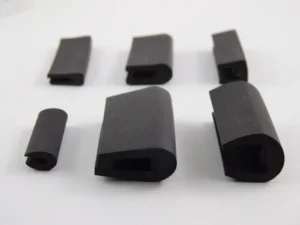
Rubber edge trim has many names. It is often called trim rubber, rubber edge trim molding, or rubber edge molding. Whatever the name, it is a versatile protection solution.
Rubber trim is mainly composed of rubber, the type of which may vary. EPDM, Neoprene, NBR, nitrile, and silicone are familiar names in this case. Each type of rubber offers unique benefits.
Rubber edge trims are highly flexible and versatile. This feature makes trim rubber suitable for use where edges may have different profiles.
Besides, rubber edge trims are known for their excellent ability to absorb impact and shock. They provide excellent cushioning and protection against impacts. As a result, you can ensure reduced risk of damage to edges and surfaces.
Finally, rubber edge trims are great for sealing properties. They can seal gaps and edges effectively to prevent moisture, dust, and debris.
Metal Edge Protectors
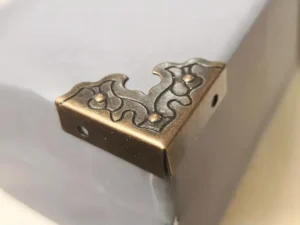
Metal edge trims are sturdy and more durable solutions, unlike rubber edge trims. These edge trims are typically made of aluminum or stainless. They offer superior protection against impact or abrasion.
Metal edge protectors are not suitable for applications requiring flexibility. In contrast, rubber or plastic edge trims are excellent in this scenario.
Plastic Edge Trim
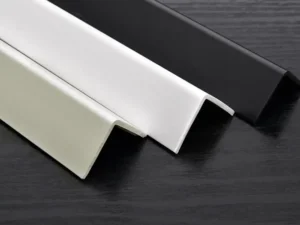
Durable plastics, such as ABS, are often used to make plastic edge trims. They are available in different sizes and types to fit various needs.
Plastic edge trim is lightweight, easy to install, and maintain. It also offers excellent resistance to corrosion and weathering. It is cheap; most importantly, you can customize the colors and finishes.
Plastic edge trim is not durable or suitable for high-temperature uses. In these cases, choose metal or rubber edge trim.
Vinyl Edge Trims
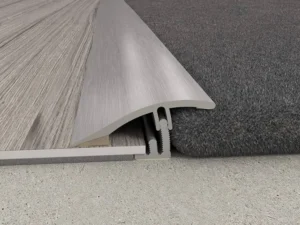
Vinyl edge trim is a type of plastic protective molding. Like other types, it is designed to cover and seal edges. However, what makes it different is its base material, PVC. It provides a clean and finished appearance.
Besides, PVC edge trim is also a popular choice for protection against abrasion and impact.
Vinyl edge trims are lightweight, flexible, and resistant to moisture, chemicals, and UV rays. They can also be easily installed and maintained, making them cost-effective.
However, the downside of this edge trim is its temperature resistance. It is suitable for high-temperature applications.
Foam Edge Trim
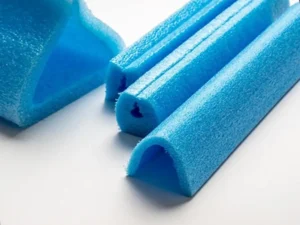
Another popular material used in edge trim manufacturing is foam. It is excellent for cushioning and protecting edges, corners, and surfaces. Foam edge trim is commonly used in the car, marine, and furniture industries.
In addition, foam edge trims are easy to install. They are also cheaper compared to other alternatives like rubber or metal trims.
However, foam edge trim has limitations in specific applications. It may not be as durable or resistant as rubber or metal edge trims and offers limited color options.
Frequently Asked Questions
What is an edge protector?
And edge protector is another name for edge trims. It is a protective material that covers edges, corners, and surfaces from damage and wear.
Is rubber edging safe?
Yes, rubber edging is generally considered safe for most applications. It provides cushioning and protection against impact and reduces the risk of injury.
How do you protect cut metal edges?
There are different ways to protect the sides of metal that have been cut. A popular method is to use metal trim or protectors. Metal edge trims cover the edges, prevent damage, and make them safer.
What is PVC edge trim?
PVC stands for polyvinyl chloride. PVC edge trim is a type of vinyl trim. It is commonly used to cover and protect edges, seams, and gaps in various applications. It is often found in construction, manufacturing, and the car industry.
Summary
Let’s wrap everything up! Edge trim is mostly a U-shaped profile used to cover various edges, such as metal, wood, plastics, or glass. Edge trim is made of different manufacturing materials and has many types. Rubber, plastic, vinyl, metal, and foam are the most common names. Each type offers unique advantages and is suitable for specific use.
Contact us if you are looking for a wide range of edge trim options. Our collection has all types of edge trim mentioned above. We also offer customized solutions for our customers. So, please don’t wait to contact us. Our team of experts is always ready to assist you.
